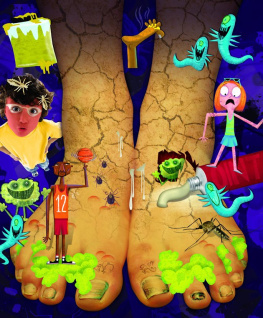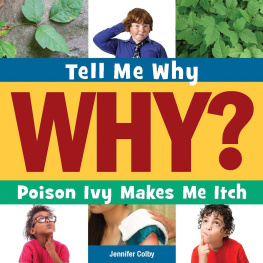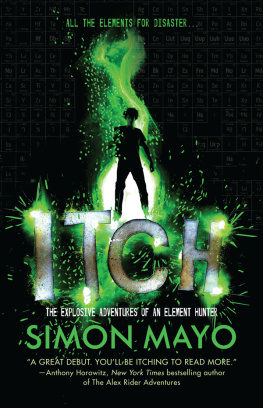LIVING WITH ITCH
A Johns Hopkins Press Health Book
Living with Itch
A Patients Guide
Gil Yosipovitch, M.D., and
Shawn G. Kwatra, M.D.

2013 The Johns Hopkins University Press
All rights reserved. Published 2013
Printed in the United States of America on acid-free paper
9 8 7 6 5 4 3 2 1
The Johns Hopkins University Press
2715 North Charles Street
Baltimore, Maryland 21218-4363
www.press.jhu.edu
Library of Congress Cataloging-in-Publication Data
Yosipovitch, Gil.
Living with itch : a patients guide / Gil Yosipovitch, M.D., and
Shawn G. Kwatra, M.D.
pages cm.(A Johns Hopkins Press health book)
Includes index.
ISBN 978-1-4214-1233-7 (pbk. : alk. paper)ISBN 1-4214-1233-0 (pbk.
: alk. paper)ISBN 978-1-4214-1234-4 (electronic)ISBN 1-4214-1234-9
(electronic)ISBN 978-1-4214-1235-1 (interactive book)ISBN 1-4214-1235-7
(interactive book)
1. ItchingPopular works. 2. SkinDiseasesPopular works. 3. DermatologyPopular works. I. Kwatra, Shawn G., 1986 II. Title.
RL721.Y67 2013
616.5dc23 2013016433
A catalog record for this book is available from the British Library.
Special discounts are available for bulk purchases of this book. For more information, please contact Special Sales at 410-516-6936 or specialsales@press.jhu.edu.
The Johns Hopkins University Press uses environmentally friendly book materials, including recycled text paper that is composed of at least 30 percent post-consumer waste, whenever possible.
The facing page is a continuation of this copyright page.
NOTE TO THE READER. This book is not meant to substitute for medical care of people with chronic itch, and treatment should not be based solely on its contents. Instead, treatment must be developed in a dialogue between the individual and his or her physician. Our book has been written to help with that dialogue.
Drug dosage: The author and publisher have made reasonable efforts to determine that the selection and dosage of drugs discussed in this text conform to the practices of the general medical community. The medications described do not necessarily have specific approval by the U.S. Food and Drug Administration for use in the diseases and dosages for which they are recommended. In view of ongoing research, changes in governmental regulations, and the constant flow of information relating to drug therapy and drug reactions, the reader is urged to check the package insert of each drug for any change in indications and dosage and for warnings and precautions. This is particularly important when the recommended agent is a new and/or infrequently used drug.
Many of the images in this publication have been provided by VisualDx. VisualDx is a patient-specific diagnostic clinical decision support system and reference tool that links the benefits of conventional systems with high-quality images and proprietary problem-oriented search. More than 1,500 healthcare institutions rely on VisualDx to improve diagnostic accuracy, enhance medical education, and engage patients in their treatment and care.
This book is available in interactive, electronic, and paperback editions.
We would like to thank Josh Tan for sharing his expertise and for traveling to help make this book possible.
We would like to thank William Safrit, Carrie OSullivan, and Anne Marie Johnson for their technical assistance.
We would like to thank Julie Block and the Coalition of Skin Diseases for their tremendous help with this book project.
We would like to thank Eric Kageyama, Krista Kellogg, Kaspar Mossman, and Susan Thornton for sharing their stories.
GY: I gratefully dedicate this book to all of those patients who suffer from chronic itch and continue to teach me daily lessons about this disease and its impact on their quality of life. I also dedicate this book to my loving wife, Galit, children, Natalie and Dan, and my parents, Shifra and Zvi, for their support, patience, and love.
SK: I dedicate this book to my devoted parents, Madan and Neelam, and sister, Gita, for their constant encouragement, love, and support.
FOREWORD
Until the mid-1990s, itch was a neglected subject. There had been very little research on it, and there was no treatment for itch as good as aspirin is for pain. Indeed, some drugs that relieve pain actually cause itch. (Doctors also use the term pruritus when talking about itch. The terms are interchangeable.)
Gil Yosipovitch became interested in the basic science and clinical aspects of itch around that time. Before long, he had founded the International Forum for the Study of Itch (IFSI) and become its first president. In 2013, IFSI held its Seventh World Congress on Itch.
Dr. Yosipovitch is driven to study itch. His research has greatly enhanced our understanding of itch and furthered our ability to treat it.
This book and its inventive format will make it possible for people who suffer from itch to understand it more completely. And its practical advice will help everyonefrom anyone who has ever been bitten by a mosquito to anyone who has ever experienced the unrelenting itch of the many skin diseases in which it causes so much suffering.
JEFFREY D. BERNHARD, M.D.
Professor Emeritus of Dermatology, University of Massachusetts
Medical School
Editor Emeritus, Journal of the American Academy of Dermatology
PREFACE
Chronic itch is a problem affecting millions of people worldwide. The goal of this book, available in both print and interactive formats, is to provide people with the information they need to better understand and manage their conditions. We start with the basics of itch and then provide an overview of the mechanisms responsible for itch transmission. After this, emphasis is placed on specific itchy conditions and unique types of itch. Last, we wrap up with a discussion of the various forms of treatment.
One of the aspects of this book that we are especially proud of is the emphasis on the emotional and psychological aspects of itch. With this in mind, the book includes several interviews and essays from people suffering from chronic itch.
We hope that this book will help provide all people (patients and doctors) with a better appreciation of chronic itch and inspire them with hope as they march forward.
Terms in bold are defined in the glossary. Did you know? features are cued with the symbol  . Also, throughout this book, you will see symbols for videos
. Also, throughout this book, you will see symbols for videos  and interactive graphics
and interactive graphics  . Visit the associated website links for multimedia features on chronic itch.
. Visit the associated website links for multimedia features on chronic itch.
A Patients Perspective
Eczema: A Lifelong Conflict
Its not every day that you see your photo in the New York Times.
Actually the Times has never run my photo, but on July 1, 2003, a series of images in the science section captured one aspect of my life so perfectly that I might as well have been the subject. Three frames from a video, featuring a Japanese man, asleep, but far from at peacewrithing in torment as he scratches his chest, his arms, his back.
The accompanying story described the studies of Gil Yosipovitch, a professor of dermatology at Wake Forest University in Winston-Salem, North Carolina, and an expert in chronic itch.
Next page









 . Also, throughout this book, you will see symbols for videos
. Also, throughout this book, you will see symbols for videos  and interactive graphics
and interactive graphics  . Visit the associated website links for multimedia features on chronic itch.
. Visit the associated website links for multimedia features on chronic itch.